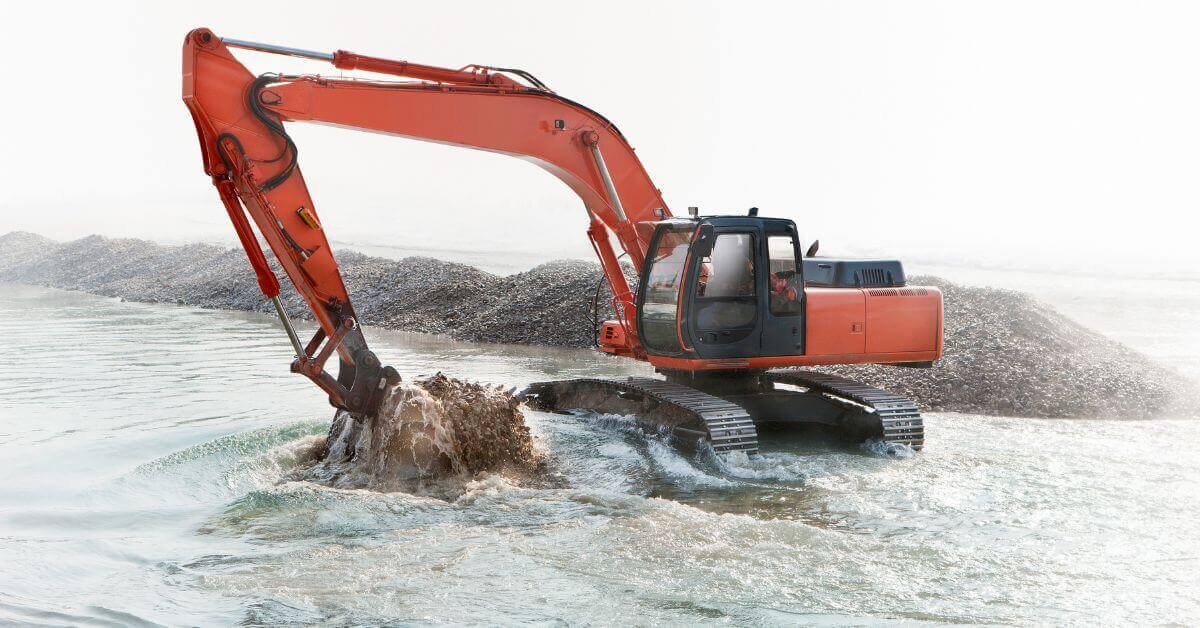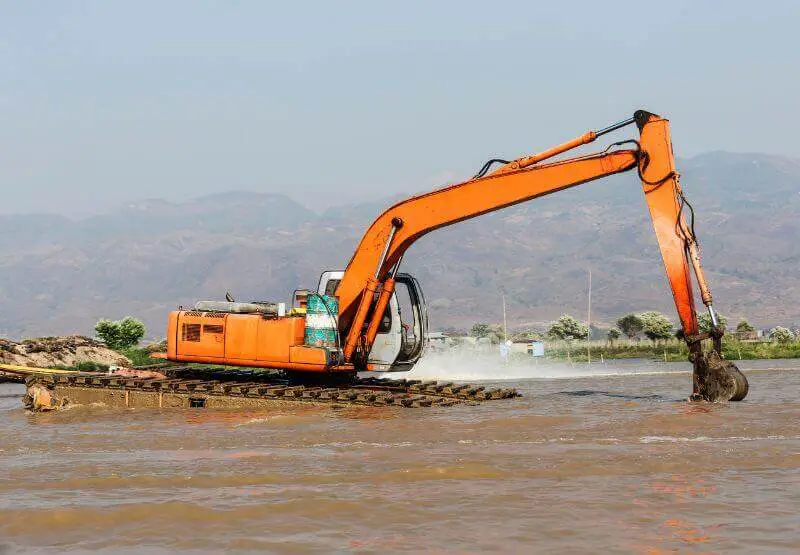With the advent of underwater construction, the need for specialized heavy equipment has become more apparent. Underwater excavators have become a game-changer in this industry, making it possible to construct bridges, roads, and pipelines in shallow and deep water.
This article will explore the different types of underwater excavators and their uses. We will also compare two popular types of excavators: Amphibious and underwater. So, if you’re curious about underwater excavators and their importance in the construction industry, keep reading!
What is an excavator?
An excavator is large, diesel-powered, mobile construction equipment used on construction sites, also called diggers. The main tool of the excavator is a multipurpose bucket that can dig into the earth to make holes, trenches, foundations and scoop the mud from the trench to load into a truck.
The excavator normally has tracks for mobility and an operator cabin that can swivel 360 degrees for versatility. The excavator has a linkage system consisting of the boom, which is pivoted to the body of the excavator, and a dipper/stick that is pivoted with the boom.
The bucket or any other excavator tool is pivoted to the stick. The boom, stick, and bucket (or any other tool fixed to the stick) form a linkage unit.
The boom and the stick have their hydraulic cylinder and piston to move them, and the bucket moves along with the stick. A hydraulic system consisting of hydraulic oil and motor driven hydraulic pump supplies the force to the hydraulic cylinder to push or retract the piston.
These movements are used for executing the excavating operations. Other attachments used in place of a bucket are a drill, grapple, hydraulic hammer, etc.
The excavator can work on land and underwater; the latter is called an underwater excavator.
Types of underwater excavators
The underwater excavator can be broadly divided into two types based on their working:
- Amphibious excavator
- Underwater excavator
Amphibious excavator
A typical amphibious excavator works in shallow water, marshland, swamp (forested wetland), and flooded areas. An amphibious excavator working in water has its tracks immersed in water (partially or completely), but the engine, operator cabin, and other systems are normally above the water.
The components of an amphibious excavator are pontoons, excavation buckets, piling vibrators, demolition equipment, dredging equipment, a pump, etc.
The amphibious excavator is useful for construction works in wetlands or shallow water (laying pipes, roads, etc.), disaster recovery efforts during floods, dredging in shallow waters, maintenance of waterways, etc.
Underwater excavator
While they can perform tasks similar to amphibious excavators, they are designed to work where amphibious excavators cannot. The underwater excavator works in deep waters and is completely submerged in water.
They can operate in water as long as the engine can get air. With their heavy weight, they can withstand moderately fast-flowing water without being washed away like a car. The underwater excavator can be subdivided into two types:
- The underwater excavator works in deep water, and an operator (a trained underwater scuba diver wearing scuba gear) executes the work. Some underwater excavators are specially built for working 300 feet under the sea. A support ship at the surface will assist and guide the operator.
- The second type of underwater excavator also works completely submerged. Still, the operator sits in a cabin at the surface and visual screens to view the actual worksite and operates the excavator using remote controls.
Many underwater excavators work with electric power and receive the electric current from the surface through an umbilical cable.
Underwater Excavators Challenges
- When an excavator works underwater, simple things like lubrication, grease, and paint on the surfaces of the excavator are important. To prevent potential corrosion issues (especially in salt water), special paints can be applied to provide protection to much of the machine’s exposed metal surfaces.
- Underwater excavators use eco-friendly organic vegetable-based lubricants and grease since spillage into the sea can cause a disaster if regular oils and grease are used. The water can continuously flush away the lubrication oil; hence, an arrangement should be established to replenish it.
- The painting of the excavator surfaces exposed to the water has to be resistant to seawater.
- The position of the engine and electrical and electronic parts are to be protected from water.
- Excavation underwater creates a cloud of dust and obstructs the view of the excavator operator, and this problem exists whether the operator works underwater or from the surface. The operator may have to be assisted by remote sensing and control equipment or similar equipment.
The Uses of Underwater Excavator
- Cutting up immersed ships.
- Backfilling or refilling an excavated hole.
- Seabed preparation (for installation of pipelines, cables, etc.).
- Recovering shipwrecks and their cargo.
- Drilling and pile anchoring (this is an undersea anchoring method).
- Underwater construction.
- Breaking underwater rocks.
- Mining in the deep sea.
Amphibious Excavators Vs. Underwater Excavators
We have discussed amphibious and underwater excavators in the preceding paragraphs; let us summarize their differences.
|
Amphibious Excavators Vs. Underwater Excavators |
||
| No | Amphibious Excavators | Underwater Excavators |
| 01 | An amphibious excavator works in shallow water. Normally the tracks are submerged, but the cabin, engine, and other parts are above the water. | The underwater excavator works deep in water, and the complete excavator is submerged. |
| 02 | The operator operates the excavator sitting in the cabin. | A trained underwater scuba diver wearing scuba gear operates the excavator submerged underwater.
Alternately, the operator sits in a cabin at the surface with visual screens to view the actual worksite and operates the machine using remote controls. |
| 03 | Used for construction works in wetlands or shallow water (laying pipes, roads, etc.), disaster recovery efforts during floods, dredging in shallow waters, maintenance of waterways, etc. | Used for cutting up immersed ships, refilling an excavated hole, seabed preparation, mining in the deep sea, underwater construction, etc. |
Conclusion
Underwater excavators have revolutionized the construction industry by making it possible to build structures in water. They are versatile and efficient and have made construction projects safer and more accessible. With advancements in technology, there are now different types of underwater excavators available, each with unique features and benefits.
Whether working in shallow or deep water, there’s an excavator for every job!






